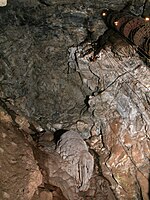Parrott's Ferry

Parrott's Ferry is a historical cable ferry site in Columbia, California in Tuolumne County, California. The site of the Parrott's Ferry is a California Historical Landmark No. 438 listed on June 2, 1949. Parrott's Ferry was built by Thomas H. Parrott in 1860. The Ferry crossed the Stanislaus River connected the mining towns of Tuttletown and Vallecito. A bridge across the river was built in 1903, ending the need for the ferry. The ferry used a large wooden flat bottom boat, a type barge. In some summers the water level was too low for the ferry to operate, so a sandbag dam was built on the river to raise the water level at the ferry. Heavy duty cables were used to pull the ferry across the river. The site is now under water, when New Melones Lake was made with the New Melones Dam filled the New Melones reservoir-lake. A historical is near the former site of Parrott's Ferry at on the Parrott's Ferry Road (E18) and the Columbia-Vallecito Highway Bridge over the Stanislaus Rive, that is 5 miles Northwest of Columbia. The marker was placed there by the California Centennials Commission working with the Aronos Research Club of Sonora on Dedicated October 2, 1949.
Excerpt from the Wikipedia article Parrott's Ferry (License: CC BY-SA 3.0, Authors, Images).Parrott's Ferry
Parrots Ferry Road,
Geographical coordinates (GPS) Address Nearby Places Show on map
Geographical coordinates (GPS)
| Latitude | Longitude |
|---|---|
| N 38.039517 ° | E -120.456417 ° |
Address
Parrots Ferry Road
95251
California, United States
Open on Google Maps






